Understanding user intent is akin to mastering the compass that points directly to the heart of your audience’s desires. Gone are the days when SEO was merely about stuffing keywords and optimizing meta-tags. Today, as search algorithms become more sophisticated, they prioritize content that best aligns with what users are genuinely seeking.
But what exactly is user intent? How does it reshape our approach to SEO? And most crucially, how can we optimize our content to resonate with this intent?
Dive into this comprehensive guide as we unravel everything you need to know about user intent, ensuring that you not only rank higher in search engine results but also create content that truly meets the needs and expectations of your audience.
What Is User Intent?
User intent, also known as search intent, searcher intent, query intent, and keyword intent, is a person’s purpose when they type a search query into a search engine.
In other words, what is it they want? What are they looking for?
Take the search query: ‘Olympics location’, for example. What is the intent behind that query?
Moz puts it like this:
“Does the searcher want to know about the Summer or Winter Olympic Games? Are they referring to an Olympics that just concluded, or one that will take place four years from now? Is the searcher attending the Olympics right now, sitting in a hotel and looking for directions to the venue for the opening ceremonies? Could they even be looking for historic information about the location of the very first Olympics in ancient Greece?”
Search engine algorithms are constantly looking at the way users interact with search results as a way of finding out what the user intent is behind a given keyword.
Here’s another example.
If you go to Google and type in “choosing a lawyer”, the search results are about choosing a law firm to represent you:
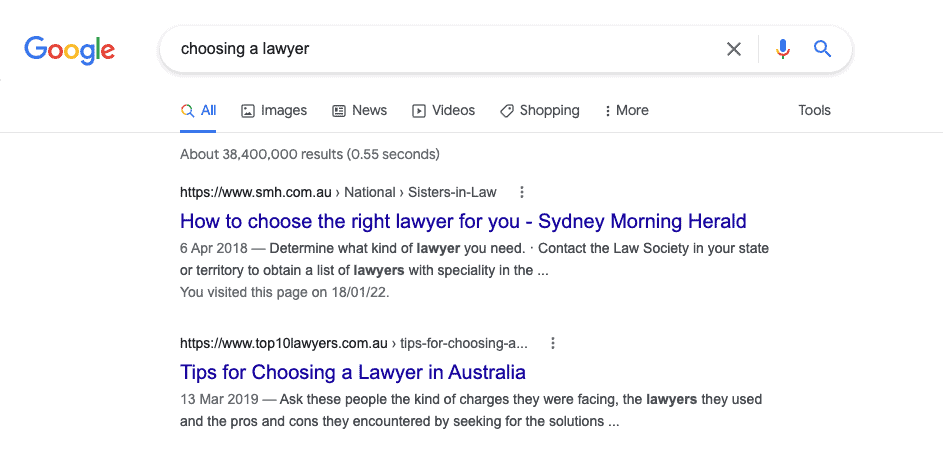
But if you type in “choosing a law firm”, the page at the top of the search results is aimed at law graduates choosing a law form to work for:
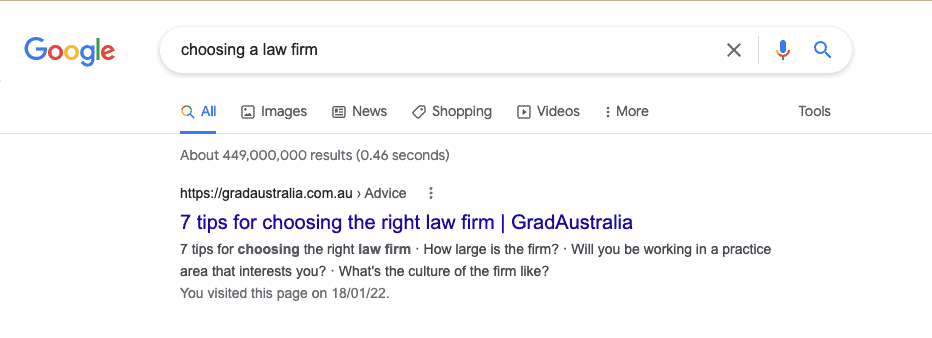
There’s not much difference between the two search queries, but they have completely different search intent.
Why Is User Intent So Important?
There are two main reasons why searcher intent is important.
1) Rank for your chosen keywords
To rank high for any keyword, you need to understand what the user intent is behind that keyword. If you don’t understand the user intent, it will be hard to rank for that keyword.
Here’s an example.
A few months back I did some keyword research in SEMrush. This tool gave me a huge list of words that have good monthly search volume and low competition.
One of these keywords was ‘best free serp checker’.
I decided I would write a blog post about best free serp checkers.
But then I typed that keyword into Google and what I found made me change my mind.
Every single result on Page #1 of Google for that search query was an application or a piece of software for checking SERP results.
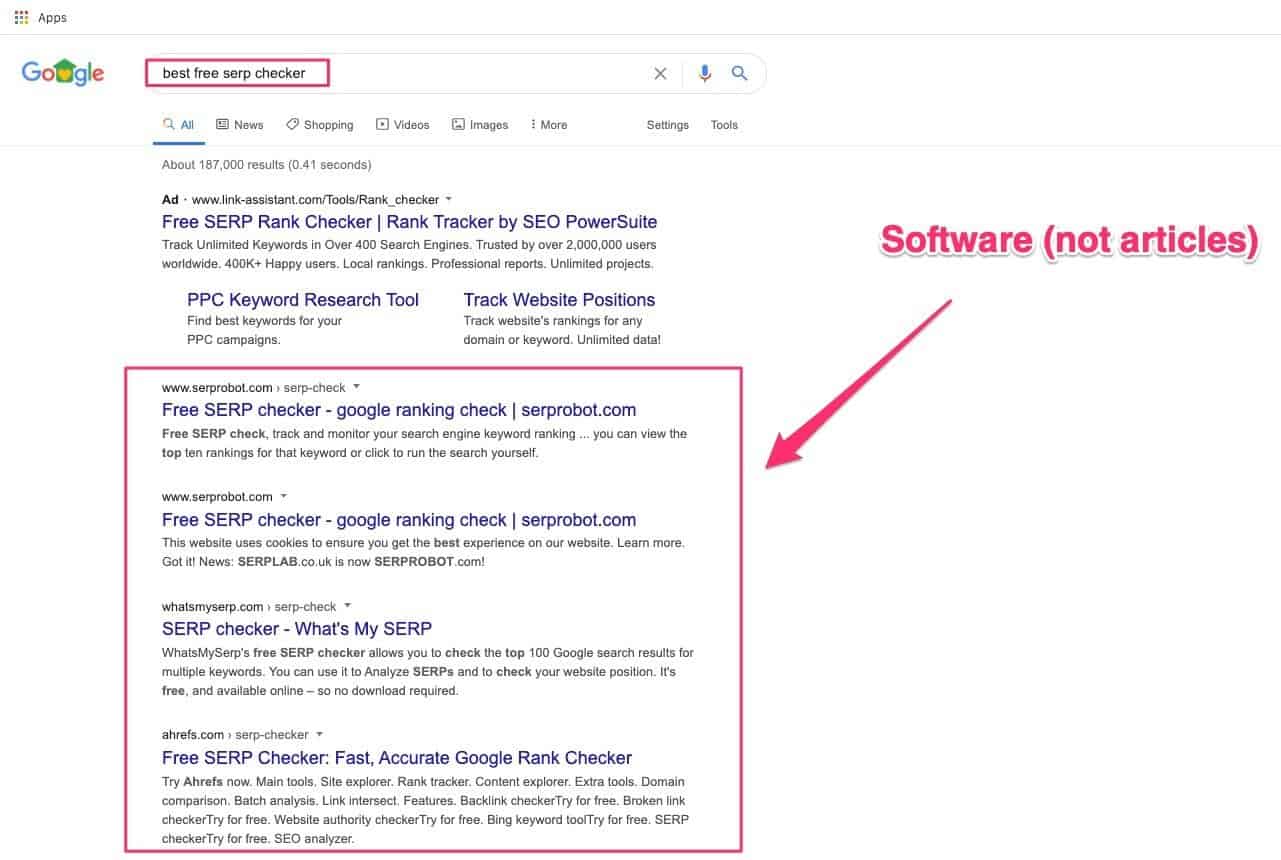
In other words, when people type in ‘best free serp checkers’, they aren’t looking for an article on that topic, they’re looking for the software itself.
Needless to say, I ditched the idea of writing an article on best free serp checkers.
It would have been a waste of time because it had no chance of ranking on Page #1 of Google.
2) Find opportunities others have missed
Understanding user intent can also help you find opportunities that other shave missed.
When you’re researching a keyword for an article, look carefully at the search results. If you see a couple of pages that are slightly off-topic, then you have a very good chance of ranking for that keyword.
Why?
Because those pages don’t match the search intent behind the keyword.
Here’s an example.
Let’s say you want to write an article on ‘how to train German Shepherds’. And in the top position, you find an article titled ‘how to train dogs’. That page doesn’t properly address the user intent behind the keyword.
And yet it’s ranking number one on Page #1 of the search results. You can easily outrank that article by writing a piece of content that matches the user intent behind the keyword.
Alternatively, let’s say you find a page that is on-topic but only contains one or two paragraphs.
Again, that tells you that you have a very good chance of ranking for that keyword. It’s unlikely that a page containing one or two paragraphs has adequately addressed the user intent behind that keyword. All you need to do is go into the topic a bit deeper, and you’ll rank higher for that keyword.
Three Types of User Intent
In understanding user intent, it helps to divide search queries into three broad categories:
- Informational
- Commercial
- Transactional
1) Informational
These are queries where the searcher is looking for information. An example would be ‘How many grams in an ounce’ or ‘what is a dslr camera’.
2) Commercial
These are queries where the searcher is looking to buy a product or a service. Examples of commercial searches would be ‘best dslr cameras’, or ‘electric lawnmowers’, or ‘flights to rome’
3) Transactional
Transactional queries are ones where the searcher has gathered all the information they need and is ready to buy. Examples of transactional queries would be ‘dslr cameras under $1000’ or ‘cheapest flights to rome’.
When you are looking at the search results for your chosen keyword, take note what kind of results are showing up in the SERPs. Are they informational, commercial, or transactional.
Your web page will need to match the type of search result that Google is showing for that keyword.
User Intent and the Buyer Journey
Another important aspect of searcher intent is how it relates to the sales funnel, also known as the ‘buyer journey’.
There are three stages in the sales funnel:
- Awareness
- Consideration
- Decision
These different stages in the buyer journey (or sales funnel) produce different kinds of user intent and different kinds of keywords.
Awareness stage
In the ‘awareness’ stage, searchers combine their main keyword with keyword modifiers such as:
- examples
- guide
- how
- how do I use [product name]
- how does [product name] work
- ideas
- improve
- issue
- learn
- optimize
- resolve
- resource
- risks
- tips
- troubleshoot
- tutorial
- upgrade
- what
- what is [product name]
- where
- who
- why
Consideration stage
In the ‘consideration’ stage, searchers use keyword modifiers such as:
- [product name] + [size, color, style]
- best
- provider
- service
- software
- solution
- supplier
- top
- what is the top
Decision stage
Searchers in the ‘decision’ stage use modifiers such as:
- [product name] in [location]
- [product name] near me
- affordable [brand name] [product name]
- benchmarks
- buy
- cheap
- compare
- compare
- coupon
- how much does [product name] cost
- order
- order [product name] online
- price
- pricing
- pros and cons
- purchase
- review
- test
- versus
- vs.
How To Understand User Intent For a Given Keyword
I mentioned earlier that search engine algorithms are able to work out what the keyword intent is behind any given search query. They do this does this by studying the way searchers click around within the search results.
If a searcher settles on a page for an extended period, it means the content on that page matches the searcher intent. But if the searcher immediately clicks back to the search results, it means the content didn’t match the user intent.
One way to determine the user intent of a keyword is to type it into Google. The results at the top of Page #1 are the ones that reflect the user intent of the keyword.
But sometimes, the search results will reflect different user intents. Here’s an example.
The search query ‘website speed’ produces mainly
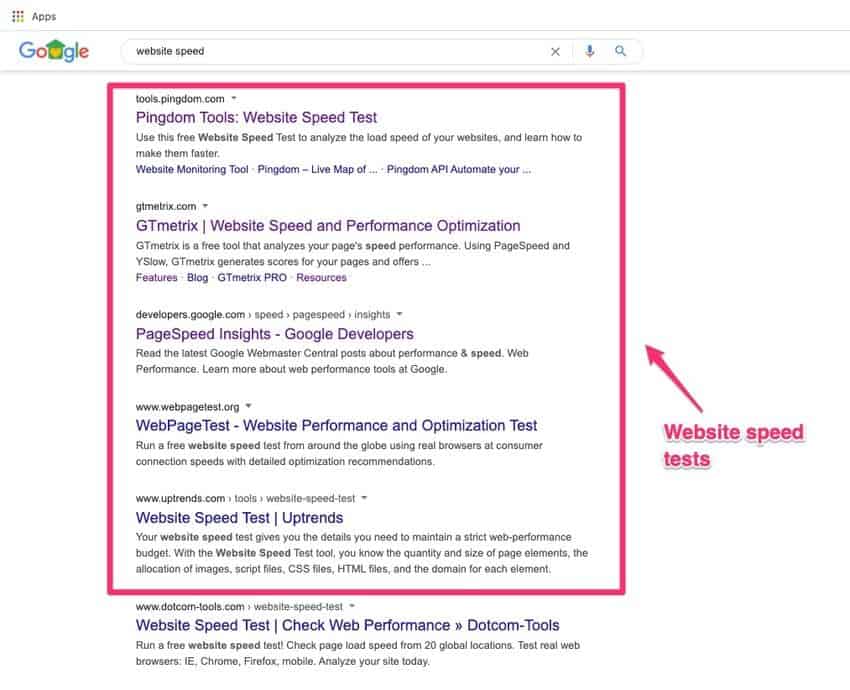
But it also produces an article about
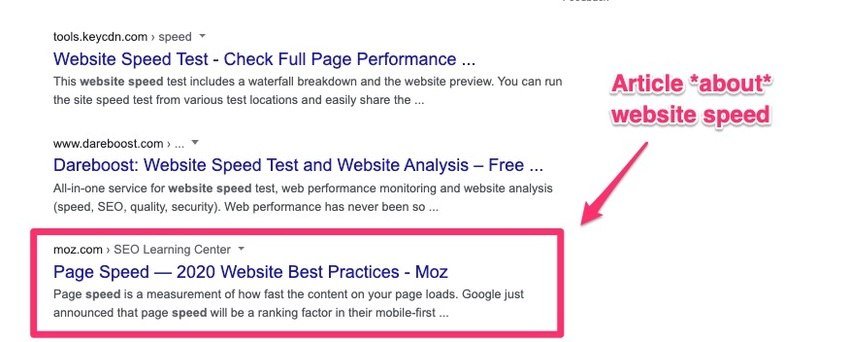
If the search results reflect more than one searcher intent, always go with the keyword intent indicated by the top-ranking pages. That’s the user intent that the search engine has concluded most closely matches the search query.
You can get more clues as to the user intent behind a keyword by looking at the ‘People Also Ask’ section in the search results. These will be closely related search queries that give you more insight into what the searcher is looking for when they type in your main keyword.
How To Implement User Intent
- When researching a keyword, look at the search results for that keyword and make sure you understand the user intent behind that keyword.
- If you’re in doubt about the keyword intent, have a look at the ‘People Also Ask’ section in the search results. Those items will give you more insight into the intent behind the keyword.
- If you see a lot of web pages that are off-topic or have ‘thin’ content, that’s a golden opportunity. You can easily rank for that keyword by producing content that better matches the user intent of the keyword and is more comprehensive.
- When designing your content strategy, make sure you target keywords that represent searcher intent at all three levels of the buyer journey (awareness, consideration, decision)
- If the search results reflect more than one interpretation of user intent, always go with the user intent indicated by the top-ranking results.
Conclusion
User intent is now a major focus of search engine algorithms. So if you want to rank well for a keyword you have to understand what the searcher is looking for.
When doing keyword research, it’s easy to focus only on search volume and keyword difficulty. But always make sure you understand searcher intent for the keyword. Because understanding user intent is the key to ranking well for any keyword.
More Articles About Keywords
- How To Use Keyword Modifiers To Rank on Google
- How to Find Seed Keywords for Better SEO
- What Is a Focus Keyword – 7 Tips For Better SEO
- Using the KWFinder Tool To Get On Page #1 of Google
- How To Use Long Tail Keywords To Get More Traffic To Your Blog
- Keyword Difficulty Scores: Can You Trust Them?
- 21 Types of Keywords in SEO & When To Use Them
- What Are Stop Words In SEO – Everything You Need To Know
- High Intent Keywords – How To Find Them Using 35 Modifiers
- The Keyword Golden Ratio: The Secret To Ranking on Google
- 31 Best Competitor Analysis Tools for Winning at SEO in 2021
- How To Do Keyword Research with SEMrush In 3 Simple Steps
- 7 Best Alternatives To Ahrefs in 2021 (SEO Tools Compared)
- Competitor Keyword Research – What It Is & How To Do It
- How To Use ‘People Also Ask’ (PAA) For Better SEO
- What Are LSI Keywords and Will They Help You Rank?
- What Is Keyword Research – A Guide For Beginners
Brilliant article as always Rob, when researching the search results is it important or not to be signed out of Google to avoid personalised results?
This is a very useful Post on search intent Rob. I gained some valuable insights from it.
Thank you.
Thanks, Trishan – I’m glad it was useful – Rob
Hi Ronan, thanks for the feedback, glad it was useful. Good question about signing out. Definitely that’s a good idea. Google is increasingly customizing the results according to personal preferences (based on search history). For example, I’ve been noticing in the last few days that on mobile, Google is showing an item in the search results labeled “only you can see this result”. So, yes – much better to open an incognito window (in Chrome) or sign out of Google before checking the results. – Rob.